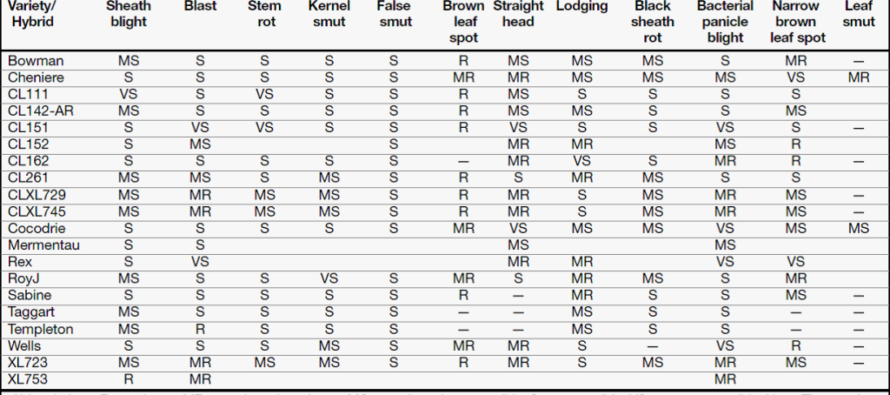Rice Leaf Blast Confirmed in Mississippi

Last week’s weather pattern in the Delta provided near perfect conditions for rice blast (Pyricularia grisea) to occur. Rice blast is generally categorized by the plant part infected (e.g., leaf, neck, panicle). Blast favors mild humid weather, frequent rainfall, and extended periods of leaf wetness. On susceptible cultivars, yield loss can be great if blast proceeds to the neck during early heading. In the fields were blast has been confirmed in the Delta, common to all were cultivation of a susceptible variety, lighter textured soil, and little to no floodwater.
Proper identification of blast is the first step in managing a field where the disease may occur. Lesions first appear on the leaves and take on a diamond shaped appearance, often having a red coloration to the border with a central tan to off gray interior. In some cases leaf lesions can appear elongated. Rice is most susceptible to blast in the mid to maximum tillering growth phase, with blast most likely appearing first on field edges or elevated (high) spots where the flood has been lost or is very shallow. Lesions are generally observed at growth stages that precede early boot. Later planted rice has a greater risk for development of blast, than earlier plantings.
Two types of resistance are available to the producer to help combat rice blast issues, with the first being selection of a cultivar with inbred resistance to blast. Many varieties commonly grown in Mississippi are rated susceptible to the blast fungus (Table 1). Varieties such as CL151 and Rex are rated very susceptible to blast and should be scouted early and often shortly after midseason. The following figure represents the disease reaction ratings for varieties/hybrids tested in the 2013 rice on farm variety trials.
The second aspect of combating blast is through “field” resistance. Field resistance basically applies best management practices to help decrease the chance of a blast event occurring under favorable conditions. Best management practices from an agronomic standpoint to help decrease or reduce the occurrence of a blast infection include proper stand density, maintaining an adequate flood level in fields after rice reaches midseason, and utilizing a proper fertility program. Excessive N application can compound blast by producing a thick dense canopy that sunlight cannot penetrate to remove leaf wetness. Potash deficiency in rice can increase the susceptibility to blast. In general, nutritionally stressed plants may be more prone to incur a yield loss from blast. Research from bordering states suggest that increasing the flood depth to 4-6” helps suppress the disease once present and provides a major reduction in the overall severity.
In general, fungicides are not applied to manage leaf blast unless the disease is killing the stand. The best management alternative is to restore or deepen the flood to provide coverage of the soil. In addition, it should be noted, that the sporulation from leaf blast lesions can also lead to infection of the panicle and result in neck blast. Numerous fungicides are labeled for management of blast. However, in fields of susceptible varieties where leaf blast has been observed a fungicide product that contains a preventive (strobilurin) and a curative (triazole) fungicide are likely the best management option. Based on information obtained from researchers in Arkansas and Louisiana fungicides that contain trifloxystrobin (Gem and Stratego) have superior activity on blast compared to fungicides that contain azoxystrobin (Quadris, Quilt, Quilt Xcel). But, fungicides that contain azoxystrobin do have good activity against blast.
Effective rate of product when applied in combination.
| Effective product in combination | ||||||
| Applicationrate (fl oz/A) | Trade name | Active ingredient (% a.i.) | FRAC Code | Pounds of a.i./gal of product | Rate of each active ingredient (fl oz/A) | Single component product |
| 14 | Quilt | azoxystrobin (7.0%)propiconazole (11.7%) | 113 | 0.621.04 | 4.24.0 | Quadris 2.08 FLTilt 3.6 EC |
| 34.5 | Quilt | azoxystrobin (7.0%)propiconazole (11.7%) | 113 | 0.621.04 | 10.310.0 | Quadris 2.08 FLTilt 3.6 EC |
| 14 | Quilt Xcel | azoxystrobin (13.5%)propiconazole (11.7%) | 113 | 1.181.02 | 7.94.0 | Quadris 2.08 FLTilt 3.6 EC |
| 27 | Quilt Xcel | azoxystrobin (13.5%)propiconazole (11.7%) | 113 | 1.181.02 | 15.37.7 | Quadris 2.08 FLTilt 3.6 EC |
| 16 | Stratego 250 EC | azoxystrobin (11.4%)propiconazole (11.4%) | 113 | 1.041.04 | 4.04.6 | Gem RCTilt 3.6 EC |
| 19 | Stratego 250 EC | azoxystrobin (11.4%)tebuconazole (11.4%) | 113 | 1.041.04 | 4.75.5 | Gem RCTilt 3.6 EC |







Let me tell You a sad story ! There are no comments yet, but You can be first one to comment this article.
Write a comment